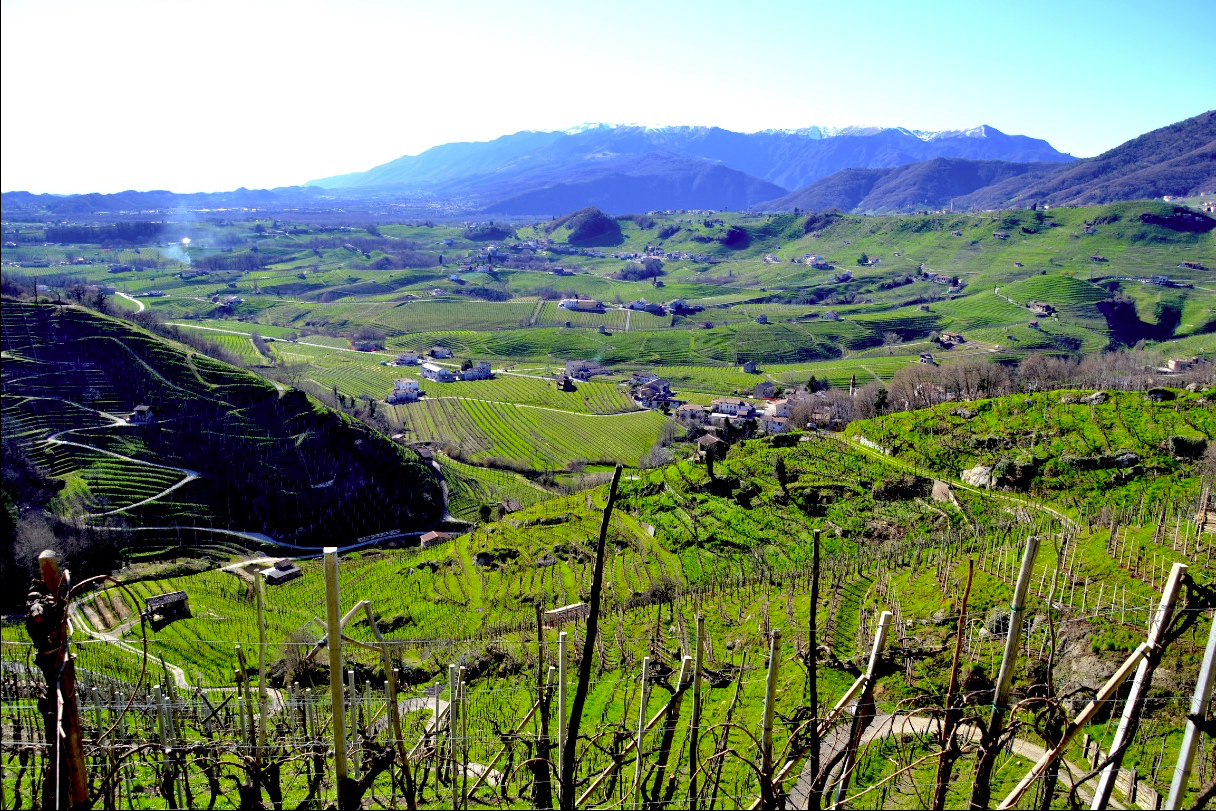Fab Wines, Grape Varieties, Vineyards, producers and terroir. Nice people with an incredible and honest passion for their territory and their wines.
Prosecco Superiore DOCG
The hilly strip of land beside the Piave River between the small towns of Conegliano and Valdobbiadene is the DOCG zone of Prosecco Superiore. This area, located between the Dolomites and Venice, is known for its high-quality Prosecco production. Valdobbiadene, in particular, is considered the heart of Prosecco production, boasting hill slopes that reach up to 500 meters, including the top-tier Cartizze variety.
Valtellina Superiore DOCG
Pliny the Elder and Leonardo di Vinci wrote about the “powerful” wines from Valtellina, a 50km alpine hillside northeast of Lake Como.

Here, an impressive 2500km of stone walls terrace the slopes so viticulture can occur, and the vines are almost all Nebbiolo, the most terroir-expressive red grape in Italy. While a lot has changed regarding the winemaking method, the simple fact remains: these steep, sun-baked slopes were excellent for wine in Roman times and are perfect for wine now. Ever heard of Valtellina? You’re not alone. What it lacks in name recognition, it more than delivers in uniqueness, elegance and aromatics.*
The sub-zones of Valtellina Superiore are:
Sassella
Maturity only after 3/5 years. It is ruby red, tending to garnet, with an intense aroma enhanced with ageing. Harmonious, dry taste, slightly tannic, it is aged for at least 24 months. It reaches optimal maturity after four to five years, and if kept well in the winery, it can age in bottles for a long time. t goes particularly well with red meats, game, cheeses and typical Valtellina cold cuts.**
Grumello
Ruby red tending to garnet, this wine has an intense and particular bouquet that improves with age. The prevalent use of Rossola and Pignola grape varieties gives it the distinctive fragrance of almonds. It is suitable for ageing in the bottle, like all Valtellina wines. his is the classic red wine for savoury dishes, including “risotto”, “polenta taragna”, “sciatt”, stews and local cheeses.**
Inferno
Ruby red tends to garnet, more robust than other wines that, with ageing, tend to soften. It is a young win. It is pleasantly tart and lively but acquires softness and elegance over the years. t is considered the most austere of Valtellina Superiore wines. t goes well with roasted red meats, game and mature cheeses.**
Valgella
This wine differs from other Valtellina wines due to its lighter colour, but this does not prevent it from improving with ageing. Nice fragrance, dry flavour, harmonious and round. Fresh floral sensations make this wine palpable even when it is young. It goes well with red meats and mature cheeses and is mainly proposed in combination with the valley’s famous dishes: “pizzoccheri”, “bresaola”, “Violino di capra”.**
Maroggia
Ruby-red tending to garnet. The taste is harmonious, dry and velvety. Produced in limited quantities (25 hectares of vineyards), the Maroggia is linked to the figure of Benigno De’ Medici who in the mid-fifteenth century stayed in this area where he found welcoming hospitality and refreshment, particularly appreciating the local wine, calling it “dulce et firmum” i.e. full-bodied and sweet. Like all Valtellina Superiore wines, it goes well with local savoury dishes, particularly meats and cheese.**
Sforzato di Valtellina DOCG
Sforzato di Valtellina (locally known as Sfursat di Valtellina) is the second DOCG appellation in Valtellina. It can be produced in all the Valtellina Superiore sub-zones, and the difference is that it is a dry passito wine (made from partially dried grapes). This brings it very much in line with Veneto’s Amarone della Valpolicella. The classic Sforzato di Valtellina wine is full-bodied, high in alcohol and rich in flavour.
Tasting Notes
Sforzato di Valtellina offers complex aromas of sweet spices (licorice, cloves and cinnamon), stewed plums, prunes, raisins, and the tell-tale hint of tar and roses, which gives away its base ingredient, Chiavennasca (the Valtellinese name for Nebbiolo).
Winemaking Process
Minimum alcohol of 14%. It can’t be vinified until December the first.
The wine’s name (either Sforzato or Sfursat on labels) derives from the traditional method of (s)forzatura delle uve , literally the ‘forcing of the grapes’. This refers to obtaining a higher alcohol level and sugar concentration in the grapes via the process of drying.
Only the best grapes are selected for Sforzato production. All rotten or damaged berries are removed as the drying process will only serve to concentrate their imperfections. The whole bunches are laid out on straw mats in well-ventilated cellars (aided by the region’s breva wind), where they remain for three or four months. During this time, the fruit loses about 40% of its weight, mostly from water evaporation, which concentrates the berries’ natural sugars and effectively turns juice into sweet grapey syrup.
After fermentation, the wine spends two years maturing between barrel and bottle. The result is a rich, full-bodied red with intense concentration and alcohol content of around 14.5%. Some winemakers have recently introduced smaller oak barrels to the process, leading to even more depth and complexity in these wines.
Some of our Producers
Prosecco Superiore
Appellations Prosecco Superiore di Conegliano Valdobbiadene DOCG and Superiore di Cartizze DOCG are:
Valtellina Superiore
Appellations: Valtellina Superiore DOCG and Sforzato di Valtellina DOCG
Piedmont
Appellations: Barbaresco, Barbera, Dolcetto, Arneis and Champenoise Method Sparkling
Sources:

Prosecco Superiore DOCG
The DOCG zone of Prosecco Superiore is on a hilly strip of land. Valdobbiadene is the heart of prosecco production with a concentration of hill slopes up to 500 metres, including the top prosecco, Cartizze.

Valtellina Superiore DOCG
Pliny the Elder and Leonardo di Vinci both wrote about the “powerful” wines from Valtellina, a 50km alpine hillside northeast of Lake Como. The vines are almost all Nebbiolo, the most terroir-expressive red grape in Italy.
